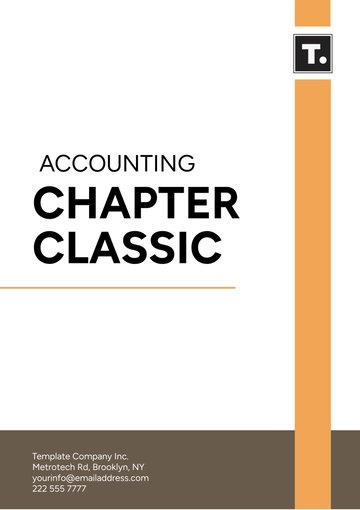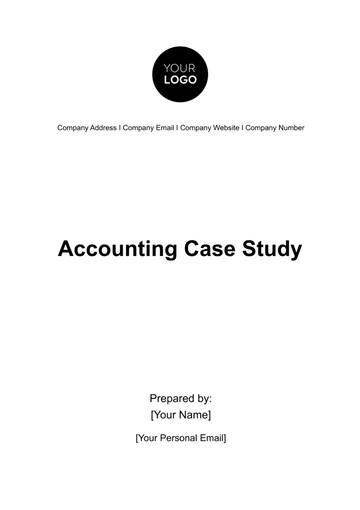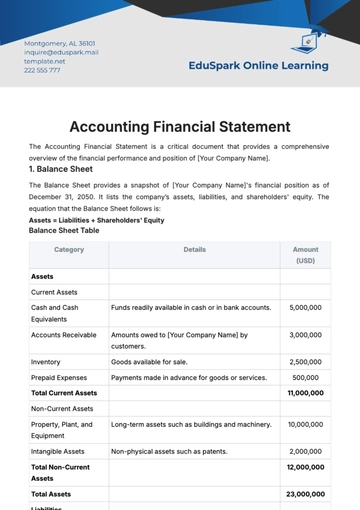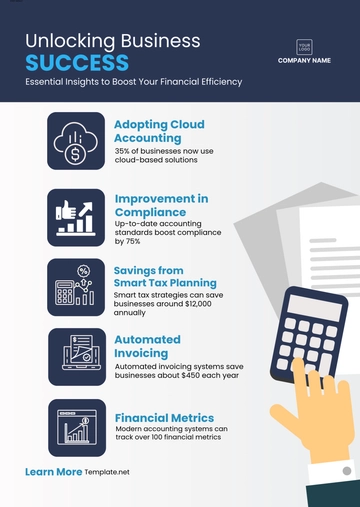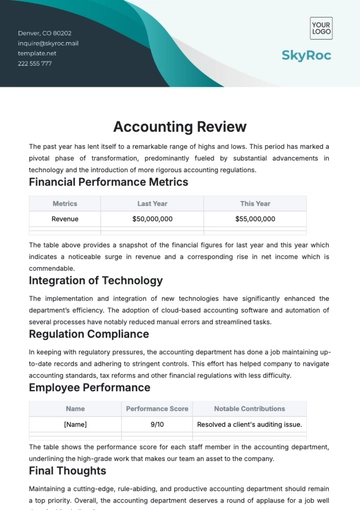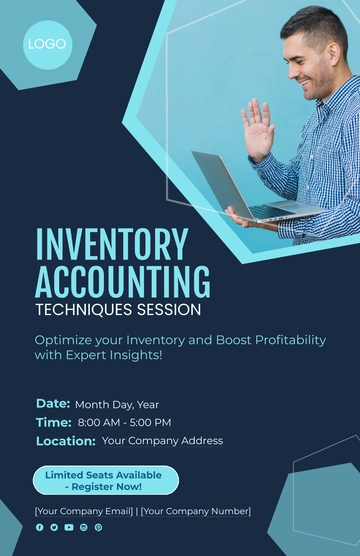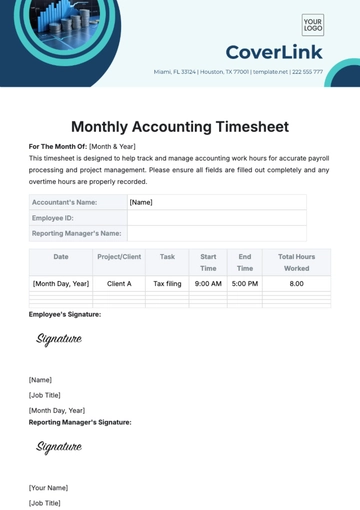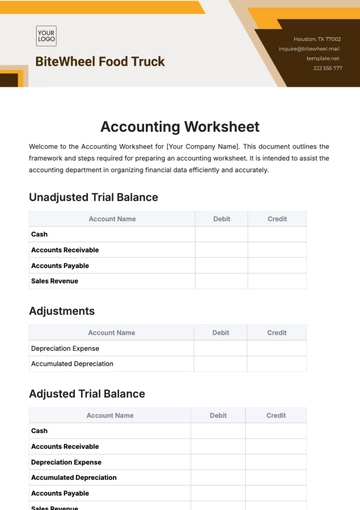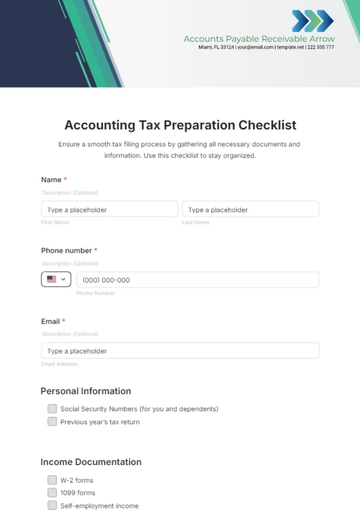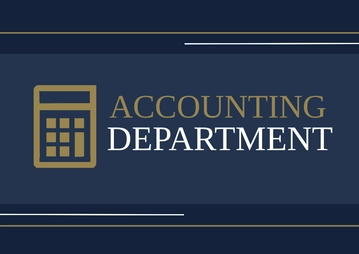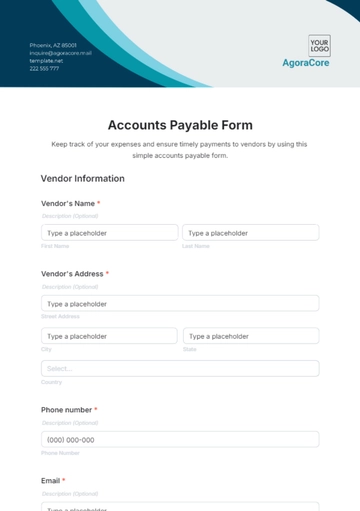Free Accounting Practices Journal

Introduction
The purpose of this journal is to provide a clear and thorough overview of how we conduct our accounting activities, ensuring transparency, accuracy, and compliance with relevant standards and regulations. This document serves as a vital resource for our internal teams, stakeholders, and auditors, offering insights into our financial processes and controls. By documenting our accounting practices, we aim to maintain consistency in our financial reporting, uphold the integrity of our financial data, and foster a culture of accountability and continuous improvement within our organization.
Company Overview
We are a mid-sized enterprise operating in the technology sector, specializing in the development and sale of advanced software solutions. With a workforce of approximately 300 employees, we cater to a diverse client base, ranging from small businesses to large corporations. Our operations span multiple countries, necessitating robust and versatile accounting practices to accommodate various financial environments and regulations.
Our business model revolves around providing innovative software products and related services, including customization, training, and ongoing support. We pride ourselves on our commitment to quality, customer satisfaction, and ethical business practices. Financially, we have maintained a steady growth trajectory, with an annual revenue averaging around $50 million in the last fiscal year. This revenue is primarily generated through software sales, licensing agreements, and service contracts.
The accounting practices outlined in this journal are reflective of our dynamic business environment and are structured to support our strategic objectives while ensuring compliance with both domestic and international financial reporting standards.
Accounting Policies
Our accounting policies are the bedrock of our financial integrity and reporting accuracy. They are crafted in compliance with universally recognized principles and tailored to meet the specific needs of our operations in the technology sector. These policies guide our day-to-day accounting decisions and ensure that our financial statements reflect a true and fair view of our company's financial position.
Compliance with GAAP: We adhere to the Generally Accepted Accounting Principles (GAAP) in the United States. This adherence ensures that our financial reporting is consistent, comparable, and transparent, adhering to the highest standards of accounting practice.
Revenue Recognition (ASC 606): Our revenue recognition follows the ASC 606 standard, recognizing revenue when a customer obtains control of promised goods or services. In the context of software sales, revenue is recognized when the software is delivered or when access to the software is provided to the customer. For long-term contracts, revenue is recognized over the period of the contract based on the progress toward completion.
Depreciation of Fixed Assets: We employ the straight-line method of depreciation for our fixed assets, including office equipment and computer hardware. This method spreads the cost of an asset evenly over its estimated useful life, reflecting a fair allocation of the asset's expense over the period it benefits the company.
Inventory Valuation: Given the nature of our products, we maintain minimal physical inventory. However, for any hardware or physical products, inventory is valued using the first-in, first-out (FIFO) method. This approach ensures that the cost recorded in the financial statements is based on the most recent prices, which is more representative of the current market conditions.
Lease Accounting (ASC 842): In compliance with ASC 842, we recognize lease assets and liabilities on the balance sheet. Lease expenses are recognized on a straight-line basis over the lease term, providing a more accurate representation of our financial commitments.
Expense Recognition: We follow the matching principle, ensuring that expenses are recognized in the same period as the revenues they help to generate. This principle is particularly applied to sales commissions and marketing expenses, which are matched with the revenues from the sales or campaigns they relate to.
Internal Controls and Procedures
Effective internal controls and procedures are fundamental to ensuring the accuracy of our financial reporting, preventing fraud, and maintaining compliance with various regulations. We have established a robust framework of internal controls that encompass a range of policies and practices designed to safeguard our assets, enhance the reliability of our financial records, and ensure adherence to legal and regulatory requirements.
Segregation of Duties: We enforce a strict segregation of duties within our accounting department. Responsibilities for authorizing transactions, recording these transactions, and managing the related assets are distributed among different individuals. This separation reduces the risk of errors and fraud, as it requires collusion between multiple parties to bypass these controls.
Regular Reconciliations: Our procedures mandate regular reconciliation of all major accounts, including bank accounts, accounts receivable, and accounts payable. This involves cross-verifying internal records with external statements, ensuring any discrepancies are promptly identified and investigated.
Authorization Protocols: We have established clear authorization protocols for financial transactions. Expenditures and other significant financial decisions require approval from designated personnel at appropriate levels of authority, ensuring that all transactions are legitimate and within policy limits.
Document and Record Management: Rigorous procedures are in place for the management of financial documents and records. This includes secure storage, proper documentation of all transactions, and maintaining a trail of records that can be easily audited.
Fraud Detection and Reporting Mechanisms: We employ various mechanisms for detecting and reporting fraudulent activities. These include whistleblower policies, regular internal audits, and financial controls designed to flag unusual or suspicious transactions.
Compliance Audits: Regular internal and external audits are conducted to evaluate our adherence to accounting standards and regulatory requirements. These audits also assess the effectiveness of our internal controls and suggest improvements.
Employee Training and Awareness: Continuous training programs are provided to our employees, focusing on best practices in accounting, awareness of potential fraud risks, and the importance of compliance and ethical behavior.
IT Security Measures: In an era of digital finance, we have implemented strong IT security measures to protect our financial data from cyber threats. This includes secure accounting software, regular data backups, and access controls to sensitive financial information.
Transaction Recording and Reporting
Accurate transaction recording and reporting are pivotal to our financial management and integrity. We employ a systematic approach to ensure every financial transaction is captured correctly and reflected in our reports. This process is crucial for providing a clear and accurate picture of our financial status at any given time, aiding in effective decision-making and compliance with regulatory standards.
Methods of Transaction Recording and Reporting
Method | Description | When Used |
Journal Entries | Recording all financial transactions in chronological order. Each entry includes date, amount, accounts affected, and a brief description. | Used for initial recording of all transactions, forming the basis of our accounting system. |
General Ledger | Posting transactions from the journal to the general ledger. The ledger categorizes transactions under respective accounts, providing a detailed account-wise view. | Used for organizing transactions into specific accounts, facilitating the preparation of financial statements. |
Trial Balance | Compiling a list of all ledger accounts and their balances at a specific point in time. This checks the mathematical accuracy of ledger postings. | Used at the end of an accounting period to ensure debits and credits balance, preceding the preparation of financial statements. |
Financial Statements | Preparing key financial reports such as the Income Statement, Balance Sheet, and Cash Flow Statement, using information from the ledgers. | Used for reporting the financial performance and position of the company, typically prepared monthly, quarterly, and annually. |
Bank Reconciliation | Comparing internal records of cash transactions to bank statements, ensuring accuracy and identifying discrepancies. | Used monthly to verify the correctness of cash transactions and to adjust for any differences. |
Account Schedules | Detailed reports for specific accounts, providing an in-depth view of transactions and balances over a period. | Used when detailed analysis of a particular account is required, such as for audit purposes or detailed financial analysis. |
Technology and Tools
In today's digital age, technology plays a crucial role in enhancing the efficiency and accuracy of our accounting processes. We have integrated various accounting software and technological tools into our financial workflows. These tools not only streamline our accounting processes but also provide real-time insights, improve data accuracy, and ensure compliance with evolving financial regulations.
Tools Used in Financial Processes
Tool | Contribution to Efficiency and Accuracy |
QuickBooks | Automates routine tasks, such as invoicing and bill payment, reducing manual errors and saving time. Offers real-time financial reporting and analysis. |
Microsoft Excel | Widely used for financial modeling, data analysis, and creating custom financial reports. Its versatility allows for tailored financial analysis. |
SAP ERP | Provides an integrated platform for managing financial operations, ensuring data consistency across various departments and functions. |
ADP Payroll System | Streamlines payroll processing, ensuring accurate and timely salary disbursement, tax calculations, and compliance with employment laws. |
Salesforce CRM | Helps in managing customer-related financial data, aligning sales data with financial reporting, and providing insights into customer profitability. |
Expensify | Automates expense report management and integrates with accounting software, enhancing efficiency in expense tracking and reimbursement. |
Tableau | Enables advanced data visualization and financial dashboards, providing deeper insights into financial trends and performance metrics. |
Case Studies/Examples of Practices
Our accounting practices, fortified by well-established policies and advanced technological tools, are best illustrated through real-world applications. The following case studies exemplify how our accounting practices are applied, showcasing their effectiveness in managing diverse financial scenarios.
Case Study 1: Implementing QuickBooks for Streamlined Invoicing
Facing challenges with manual invoicing and tracking payments, we transitioned to QuickBooks, automating our invoicing process. This shift significantly reduced manual errors and processing time. The automated follow-up feature on overdue invoices improved our accounts receivable turnover ratio by 30% within six months, enhancing our cash flow management and providing more accurate financial reporting.
Case Study 2: Utilizing SAP ERP for Financial Integration
As we expanded our operations, the need for a unified financial management system became crucial. Implementing SAP ERP enabled the integration of financial data across various departments, from procurement to sales. This integration provided a cohesive view of our financial status, reduced data redundancy, and improved decision-making accuracy. The system's real-time reporting capability allowed for timely financial analysis and strategic planning.
Case Study 3: Advanced Data Analysis with Tableau
To gain deeper insights into our financial performance, we integrated Tableau for advanced data visualization. By analyzing sales and expense data through Tableau, we identified underperforming products and optimized our product portfolio. The visualizations also helped in pinpointing seasonal trends in sales, guiding us in strategic marketing and inventory planning. This led to a 20% increase in sales efficiency and a 15% reduction in inventory costs.
Auditing and Compliance
Auditing and compliance are critical components of our financial governance. We adhere to a stringent auditing process, both internal and external, to ensure our financial practices comply with regulatory standards and accurately reflect our financial position. Our commitment to these practices ensures not only adherence to legal and regulatory requirements but also reinforces the trust and confidence of our stakeholders in our financial reporting.
Internal Auditing: Our internal auditing process involves a thorough examination of our accounting records, policies, and procedures. Conducted by an independent internal audit team, these audits are aligned with the standards set by the Institute of Internal Auditors (IIA). We ensure compliance with the Sarbanes-Oxley Act (SOX) requirements, particularly in terms of internal control over financial reporting. Any discrepancies identified during these audits are addressed immediately through corrective actions, process improvements, or additional staff training.
External Auditing: Annually, an independent external audit firm conducts a comprehensive audit of our financial statements. This audit is in accordance with Generally Accepted Auditing Standards (GAAS) and aligns with the requirements of the Public Company Accounting Oversight Board (PCAOB). The focus is on verifying the accuracy of our financial statements and ensuring compliance with Generally Accepted Accounting Principles (GAAP). Any findings or suggestions for improvement are taken seriously, and necessary changes are implemented to enhance our accounting practices.
Regulatory Compliance Audits: Periodically, we undergo regulatory compliance audits conducted by relevant financial authorities. These audits assess our compliance with specific regulations such as the Internal Revenue Service (IRS) codes and state-specific financial regulations. Compliance with these regulations is critical, and we proactively work to ensure that all our financial practices, tax filings, and reporting are in full compliance. In the case of non-compliance issues, we take immediate steps to rectify the situation and prevent recurrence.
Continuous Monitoring and Improvement: Beyond formal audits, we have a system of continuous monitoring of our financial processes. This ongoing review helps in identifying and addressing any potential issues proactively. We consistently update our practices in response to new regulatory changes, accounting standards updates, and industry best practices.
Challenges and Solutions
Accounting practices often come with their set of challenges, especially in a dynamic business environment. It is crucial to adapt and evolve to address these challenges effectively. Here, we highlight some common challenges we have encountered and the solutions and strategies we have implemented to overcome them.
Challenge 1: Managing Complex Regulatory Changes
Solution: The regulatory landscape in the financial industry is constantly evolving. To stay compliant, we have established a dedicated regulatory compliance team. This team closely monitors changes in financial regulations, conducts regular training sessions for employees, and ensures timely updates to our accounting policies and procedures to align with new requirements.
Challenge 2: Data Security and Privacy
Solution: With increasing concerns about data security and privacy, we have implemented robust cybersecurity measures. This includes regular security audits, employee training on data protection, and the use of encryption and secure communication channels for sensitive financial data.
Challenge 3: Handling High Transaction Volumes
Solution: As our business grew, we encountered a surge in transaction volumes. To handle this, we adopted advanced accounting software that automates transaction processing, reducing manual effort and errors. Additionally, we optimized our chart of accounts for efficiency and scalability.
Challenge 4: Maintaining Accuracy in Complex Transactions
Solution: Complex financial transactions, such as mergers and acquisitions, require meticulous handling. We engage external experts for specialized advice, conduct detailed due diligence, and maintain a dedicated team to oversee these transactions. Regular reconciliation and peer reviews ensure accuracy.
Challenge 5: Talent Retention and Skill Development
Solution: Attracting and retaining skilled accounting professionals is a priority. We offer competitive compensation packages, professional development opportunities, and a positive work culture. Employee skill development is encouraged through certifications and training programs to stay up-to-date with industry best practices.
Challenge 6: Efficient Cash Flow Management
Solution: Efficient cash flow management is critical. We have implemented cash forecasting models that project cash needs and surpluses, allowing us to make informed investment and financing decisions. Additionally, we have established credit policies to optimize receivables and payables.
Challenge 7: Stakeholder Communication and Transparency
Solution: Maintaining open and transparent communication with stakeholders is vital. We have implemented regular financial reporting mechanisms and investor relations programs to ensure stakeholders are well-informed about our financial performance, objectives, and strategies.
Recent Updates and Changes
As part of our commitment to continuous improvement and adaptability, we regularly assess and update our accounting practices to align with emerging trends, technologies, and regulatory requirements. Here, we provide an overview of recent updates and changes we have implemented in our accounting practices.
Change Description | Rationale | Impact |
Transition to Cloud-Based Accounting Software | Enhanced accessibility, scalability, and data security. | Improved real-time collaboration and data access. |
Integration of Artificial Intelligence (AI) | Streamlining routine tasks and data analysis. | Increased efficiency and data accuracy. |
Strengthened Cybersecurity Measures | Mitigation of evolving cybersecurity threats. | Enhanced data protection and privacy. |
Adoption of Sustainability Accounting Standards | Addressing environmental and social impact reporting. | Enhanced corporate social responsibility (CSR) reporting. |
Enhanced Internal Control Framework | Strengthening internal controls to prevent fraud. | Improved risk management and compliance. |
Best Practices
Our commitment to excellence in accounting is underpinned by a set of best practices that guide our financial management and reporting. These practices serve as a foundation for the reliability, accuracy, and transparency of our financial operations.
Regular Reconciliation: We conduct regular reconciliations of accounts, ensuring that financial data is accurate and consistent across various records.
Documentation: Comprehensive documentation of financial transactions and policies is maintained to facilitate transparency and compliance.
Segregation of Duties: We implement strict segregation of duties to prevent conflicts of interest and maintain internal controls.
Timely Financial Reporting: Financial reports are prepared and reviewed promptly, enabling informed decision-making by management.
Continuous Training: Our accounting team undergoes regular training to stay updated with the latest accounting standards, technologies, and regulations.
Data Backup and Security: Data is securely stored, backed up, and protected against loss or unauthorized access.
Ethical Conduct: We uphold ethical standards in financial reporting and transactions, maintaining trust and integrity.
Conclusion
In this comprehensive journal document, we have delved into the core aspects of our accounting practices, policies, and principles. Our commitment to maintaining the highest standards of financial management and reporting has been evident throughout the document. We continuously strive for accuracy, transparency, and compliance with evolving regulatory requirements.
Our accounting practices are not static but adaptive, as demonstrated by our recent updates and changes, which reflect our dedication to staying at the forefront of industry best practices. We emphasize the importance of ongoing training, ethical conduct, and a strong internal control framework to ensure the reliability and integrity of our financial operations.
As we move forward, we remain committed to upholding these principles and practices, fostering a culture of excellence and accountability in our financial endeavors.
- 100% Customizable, free editor
- Access 1 Million+ Templates, photo’s & graphics
- Download or share as a template
- Click and replace photos, graphics, text, backgrounds
- Resize, crop, AI write & more
- Access advanced editor
Elevate your accounting documentation with the Accounting Practices Journal Template from Template.net. This template is expertly designed to be both editable and customizable, fitting perfectly for recording various accounting practices. Effortlessly modify it to suit your specific needs using our AI Editor tool. Template.net offers a structured and efficient way to maintain an organized journal of accounting practices.





